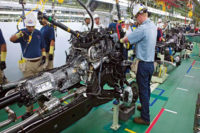Ergonomic Tips for Assemblers


One goal of ergonomics is to limit the torque reaction felt by assemblers who use power tools. Photo courtesy Stanley Assembly Technologies
* Be aware that while numerous ergonomic guidelines exist, it might be hard to find a concise set of guidelines to cover all areas of a specific industry.
* Properly evaluate the ergonomic risks in a plant. This requires the use of analytical tools, with information regarding these tools available through industry associations, standards and other organizations such as the National Institute for Occupational Safety and Health, says Colin Brigham, CIH, CSP, CPE, CPEA, ergonomist with TRC Companies Inc..
* Before purchasing a workstation, consider the tools and components that need to be used and stored there. Bob Simmons, senior vice president of Pro-Line says workstations can be equipped with such features as electric outlets, pneumatic power supply, tool balancers, overhead lighting, articulating or removable bin arms, and articulating screen-monitor arms. The latter improve ergonomics by letting workers move or tilt the screen up or down, in or out, and forward and backward. Articulating monitor arms also improve productivity by making it easier for the worker to see and follow assembly instructions presented on the screen.
* Ergonomics is a much greater concern with continuous drive power tools vs. discontinuous drive tools. Ken Maio, business development manager for AIMCO, recommends assemblers always use anti-vibration sockets with discontinuous drive tools to improve torque delivery given their higher free speeds. These sockets also extend tool life by lessening vibration and wear on the pulse tool anvil.

Workstations can be equipped with electric outlets, pneumatic power supply, tool balancers, and articulating or removable bin arms. Photo courtesy Pro-Line
* Pay attention to the pistol-grip design of hand tools. Workers wrists are naturally at an angle, yet most hand tools have a grip that requires the tool be held at 90 degrees. Holding the tool at 90 degrees for extended periods of time puts extra strain on the wrist.
*Materials, equipment and work-in-process must be moved into the workcell ergonomically. DC-powered, servo-controlled lift-assist devices let workers pick up and move these items with as little as 1 to 2 pounds of force.
“There is a lot of evidence that effective ergonomics programs improve productivity and are good for American industry,” says Brigham. “Ergonomics is a win-win if you make it part of your normal business operations.”
Looking for a reprint of this article?
From high-res PDFs to custom plaques, order your copy today!




